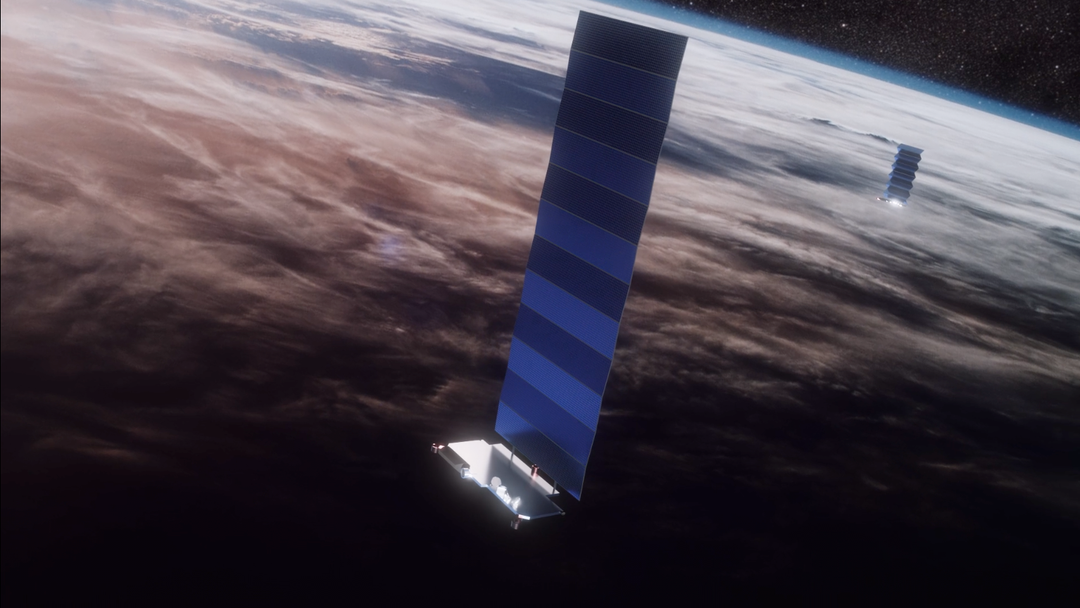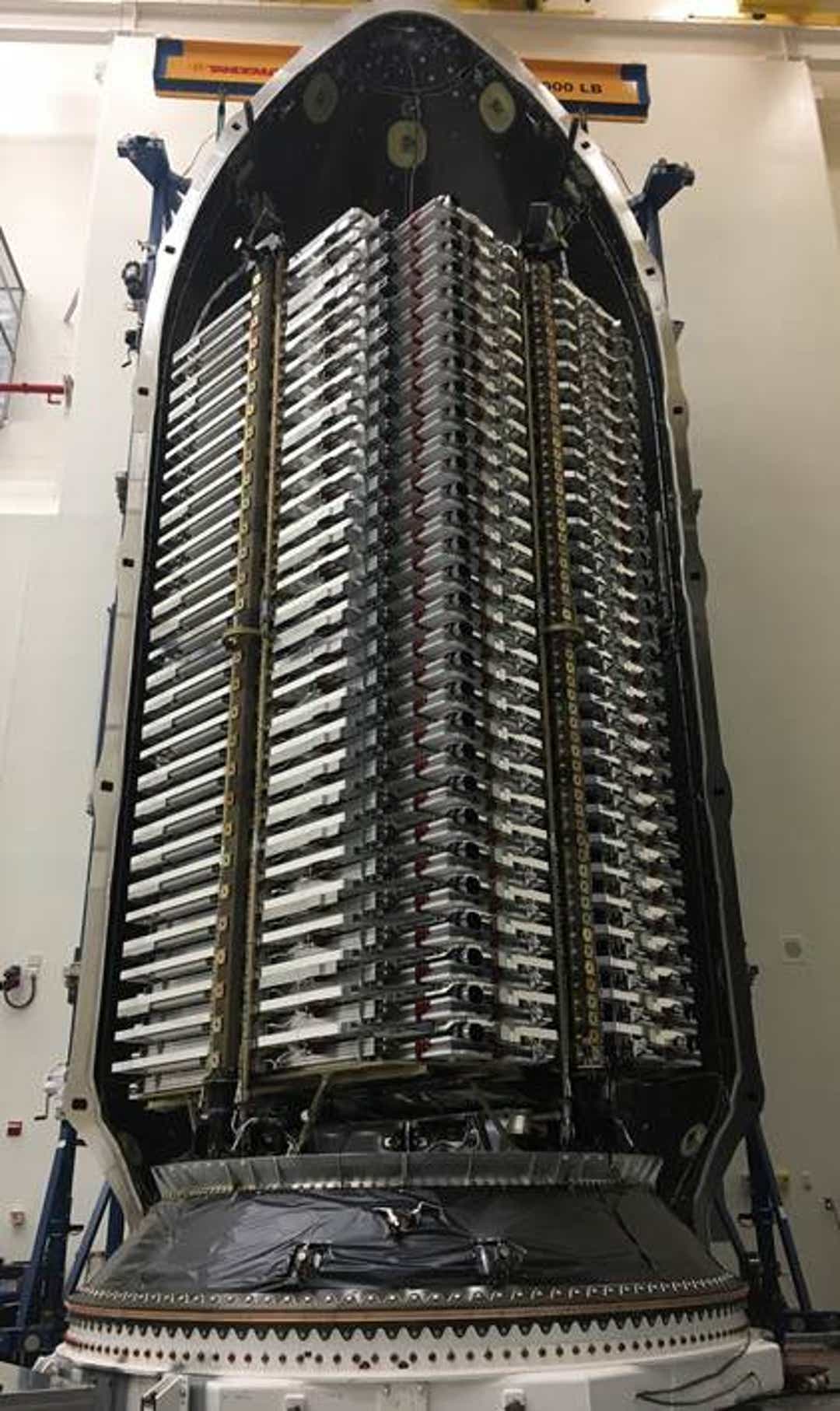SpaceX will expand on its well-known telecommunications ambitions Monday with the launch of a Falcon 9 rocket from Cape Canaveral, but the company will also quietly cross a significant threshold and become the second-largest satellite operator in the world — on top of its already dominant position as a launch provider.
The 9:55 a.m. liftoff from Launch Complex 40 will take 60 more of the company’s Starlink satellites to low-Earth orbit as part of the program designed to beam internet connectivity down to the ground, pushing the constellation’s total size to 120 after a debut launch in May. That will put it above heavyweights like NASA, the Air Force, and Iridium when it comes to the sheer number of spacecraft on orbit.
SpaceX plans on putting thousands of its own Starlink spacecraft into orbit – possibly up to 40,000 and beyond – then continually refreshing the constellation as some are lost to orbital decay. Despite the challenges and high costs with deploying a system of this magnitude, CEO Elon Musk sees it as a way to pay for his company’s future deep-space initiatives, like the Starship vehicle and Super Heavy booster. He also hopes it increases internet connectivity to underserved regions of the world.
Monday’s tipping point launch

There are stark differences between Starlink spacecraft and the vehicles operated by more established operators. National security satellites, for example, can weigh more than 12,000 pounds when fueled, operate thousands of miles above Earth, and require complicated ground systems. Starlink satellites, meanwhile, weigh just 500 pounds and operate a few hundred miles in altitude.
According to the Space Foundation, a nonprofit based in Colorado that advocates for space industries around the world, the launch will propel SpaceX to the No. 2 position from a number-on-orbit standpoint:
- Planet: 197 Earth observation satellites
- SpaceX: 120 internet-beaming satellites (117 after contact was lost with three in May; expected to deorbit and burn up)
- Iridium: 106 communications satellites
- Air Force: A mix of 98 classified, communications, Earth observation, position and navigation, and technology development satellites
- Spire: 85 Earth observation satellites
- NASA: 67 science, Earth science, technology development, and communications satellites (includes International Space Station)
With just two more Starlink launches, scheduled to happen by next year, SpaceX will eclipse Planet to become the No. 1 operator by volume.
“They set a very aggressive plan and stuck to it,” said Rich Cooper, Space Foundation’s vice president of strategic communications and outreach. “Monday’s launch will further accelerate their accomplishment of that timeline.”
One of SpaceX’s key advantages with Starlink, however, isn’t that it designs and builds the satellites. The company also controls the ride to orbit through its family of reusable Falcon 9 rockets.
“Look, this is competition,” Cooper said. “Diversifying your portfolio makes you a stronger, more resilient company. When you can provide the full suite of services that SpaceX is showing that they’re able to do – being the launch provider, the integrator, and the (satellite) operator – it separates you from a lot of your competition.”
But it’s not just about sheer numbers – the Starlink constellation’s expansion and overall message is having serious impacts on the spaceflight, communications, and satellite industries. As one of a few companies authorized by the Federal Communications Commission to operate in space, SpaceX is pushing the boundaries of regulations, too.
“The launches themselves are having less of an impact on the marketplace as much as what they’re doing and what they’re signaling they want to do,” said James Dunstan, founder of Mobius Legal Group, an outer space and telecommunications law firm. “And that’s got everybody in a real tizzy.”
Several factors contribute to that state of nervous excitement, ranging from the FCC’s approval allowing Starlink to occupy lower altitudes to the company’s most recent plan that quadruples the size from an initially planned 11,000 to more than 40,000 satellites. The biggest concern, Dunstan said, is that some of the satellites will become orbital debris.
“The interesting part of it is that now, the FCC is going to be the real battleground for orbital debris,” Dunstan said, noting that the agency, while competent, doesn’t have the expertise to seriously manage debris decisions. “Fundamental, generation-lasting policy decisions are going to be coming out of an agency that’s not really equipped or trained to be making them.”
To date, SpaceX has said the low altitudes are actually an advantage for Starlink, enabling older spacecraft to cleanly burn up in the atmosphere.
Paying for future endeavors

Capturing just 5% of the trillion-dollar worldwide telecommunications industry, Musk says, would secure SpaceX with $50 billion a year. That’s magnitudes more than the $4.6 billion available in launch services, according to the Satellite Industry Association’s 2018 report.
"We see this as a way for SpaceX to generate revenue that can be used to develop more and more advanced rockets and spaceships," Musk said before the first flight in May. "We think this is a key stepping stone on the way toward establishing a self-sustaining city on Mars and a base on the moon.”
Experts also believe experience gained in the deployment of Starlink could carry over to those far-flung goals, too. If it works as planned, similar constellations could be deployed in orbit around the moon and Mars, connecting deep-space inhabitants to each other – and Earth.
Milestones for SpaceX
Payload aside, Monday’s launch will mark two major milestones for SpaceX.
First, the company will fly with a fully reused fairing, or the nose cone that protects spacecraft during launch. Musk has long sought to save on launch costs by reusing the hardware, which can cost millions of dollars when simply tossed into the ocean after liftoff. During a Falcon Heavy mission in April, however, two fairing halves were recovered and will fly with Starlink. Since it’s an in-house mission, this helps SpaceX further reduce costs.
Second, the Falcon 9 first stage flying on Monday will mark the fourth flight of the SpaceX booster. To date, no Falcon booster has flown no more than three missions before being retired, but this one will help the company push toward its goal of using them 10 times or more.
About eight minutes after liftoff, the 156-foot-tall first stage will target a drone ship landing in the Atlantic Ocean. If it survives and is serviceable, it could someday fly a fifth time.
Contact Emre Kelly at aekelly@floridatoday.com or 321-242-3715. Follow him on Twitter, Facebook and Instagram at @EmreKelly.
"make" - Google News
November 09, 2019 at 06:17AM
https://ift.tt/34K8Ho0
SpaceX's next Starlink launch will make it one of the top satellite operators in the world - Florida Today
"make" - Google News
https://ift.tt/2WG7dIG
Shoes Man Tutorial
Pos News Update
Meme Update
Korean Entertainment News
Japan News Update
No comments:
Post a Comment